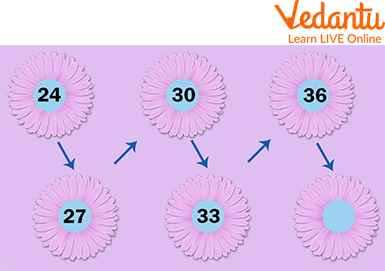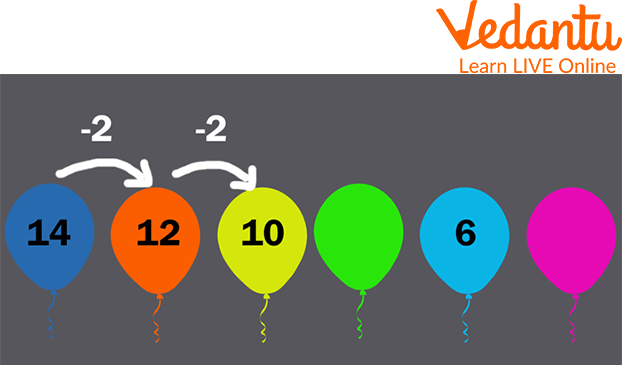




Introduction to Pattern and Rules
Do you know what patterns are? Or how to identify them? What to do after identifying them? How are they helpful? Patterns can be anything that is repeated after some time, a design, number, formula, or even a rule. What are the rules? Rules are a set of words that guide you about a particular way of doing something. Today, we will discuss patterns and rules in Maths. We will also discuss how these patterns or rules can solve any problem. By the end of this, we will solve a few examples.
What is a Pattern in Maths?
Patterns in Maths are also called sequences, and these are sets of terms that contain a formula that repeats itself after some time.
Number Patterns
Number patterns are where numbers follow a certain formula and make a sequence from it. There are various types of number patterns, namely, Arithmetic, Geometric, and Fibonacci sequences.

Number Patterns Example
Arithmetic Pattern
Also known as an algebraic pattern, a sequence is formed by adding or subtracting.
Example: 1, -1, -3, -5, -7, -9, and so on.
In the given example, 2 is subtracted from the preceding number, creating the sequence.
1 - 2 = -1
-1 - 2 = -3, etc.
Geometric Pattern
These are formed by using multiplication or division
Example: 1, 2, 4, 8, 16, 32…
Here, we are multiplying 2 to get the next term of the sequence.
1 $\times$ 2 = 2
2 $\times$ 2 = 4, …
Fibonacci Pattern
This is a sequence formed by adding the previous two terms of a sequence.
Example: 0, 1, 1, 2, 3, 5, 8, 13, and so on.
Here, we are adding the first two terms, then the next two, and so on.
0 + 1 = 1
1 + 1 = 2
1 + 2 = 3
2 + 3 = 5, and so on.
Types of Patterns
There are various types of sequences in Maths:
Repeating Patterns
These patterns have rules that keep repeating after some time.
Growing Patterns
These patterns keep growing, which means the value of terms keeps increasing.
Example: In the image given below, 2 is added to the previous number.

Growing Patterns
Shrinking Patterns
These patterns keep shrinking or getting smaller, which means the value of terms keeps decreasing.
Example: In the image given below, 2 is subtracted from the preceding number.

Shrinking Pattern
Rules in Maths
Let’s see the definition of rules in maths. Every pattern has some kind of rule. These rules are used to find missing terms in a sequence, much like adding a number. When trying to understand the nature of the sequence, we use the difference between two consecutive terms to find the rule.
Let’s take an example: 1, 8, 27, 64, 125, etc.
Let the first term be $a_0$, the second be $a_1$, the third be $a_2$, and so on.
Now $a_0$ = 1, which is = 1$\times$1 = 1$\times$1$\times$1,
$a_1$ = 8, which is = 2$\times$2$\times$2,
$a_2$ = 27, which is 3$\times$3$\times$3.
Here, the nature of the sequence is geometric, as the number is the cube of the position of the number (The first number in the sequence is the cube of one, and the second is the cube of 2).
Solved Examples
Now that we have learned about patterns and rules, we will try to solve some examples of patterns and rules examples.
Q 1: Determine the P value in the sequence of numbers: 1, 4, 9, P, 25.
Ans: In the given sequence, the pattern that we see is that every number is the square of the counting numbers.
The square of 1 is 1, the square of 2 is 4, and so on.
Hence, the missing number 'P' is a square of 4, which is 16.
Example 2: Find the value of P and Q in 1, P, 9, Q, 25.
Ans: $1 = 1 \times 1$
$9 = 3 \times 3$
$25 = 5 \times 5$
This explains that a term's value in the given sequence depends on its position. If the position is n, then the term's value is $n^{2}$.
So, $P = 2 \times 2 = 4$ and $Q = 4 \times 4 = 16$.
Example 3: Determine the value of D in the sequence of numbers: 11, 17, 23, 29, D, 41, 47, 53
Ans: By adding the number 6 to the given sequence, we can see the pattern of every number increasing.
11 + 6 = 17, 17 + 6 = 23, and so on.
Hence, the missing number D is 29 + 6 = 35.
Try Some Yourself
Now that we have solved a few examples, let’s see if you can solve some on your own too.
Q 1. Find the value of A and B in 0, A, 8, 15, and B.
Ans: A = 3 and B = 24.
Hint: Subtract one from the square of the position of the term.
Q 2. Find the value of R and S in R, 2, 3, 4, S.
Ans: R = 1 and S = 5.
Q 3. Find the missing numbers in the pattern: 8, ______, 16, ______, 24, 28, 32.
Ans: 12, 20
Summary
Learning patterns improves our ability to spot patterns. We see a pattern that prompts us to think about and determine the rule that will allow the pattern to continue. We use rules to find terms missing from a given pattern. Rules can be found using the relation and difference between two consecutive numbers in a pattern. A pattern in maths is a set of numbers that relate to each other, forming a sequence. Number patterns can be of three types: Arithmetic, Geometric and Fibonacci patterns, while patterns have three types, namely, Repeating, Growing, and Shrinking. As the name suggests, repeating patterns have rules that repeat while the value of terms increases in Growing patterns and decreases in Shrinking patterns.
FAQs on Identifying Patterns and Rules
1. How are patterns and rules useful?
We can find patterns between things and their rules and use them to solve any problem or find a missing term.
2. What do you mean by arithmetic?
Arithmetic is the study of numbers and relations among them using various properties and using those properties to solve problems.
3. How do you identify patterns?
We can identify patterns by finding the relation or difference between two consecutive terms in a given pattern. We also need to find the nature of the pattern to understand how to identify rules.











